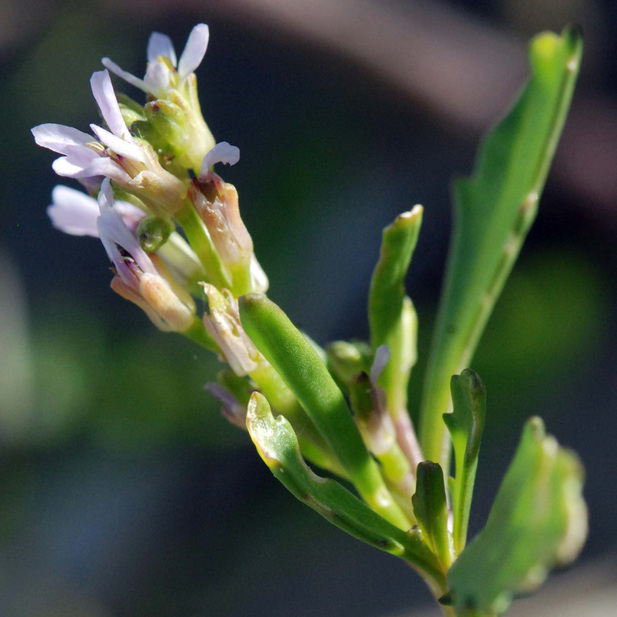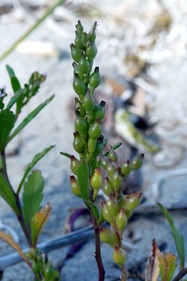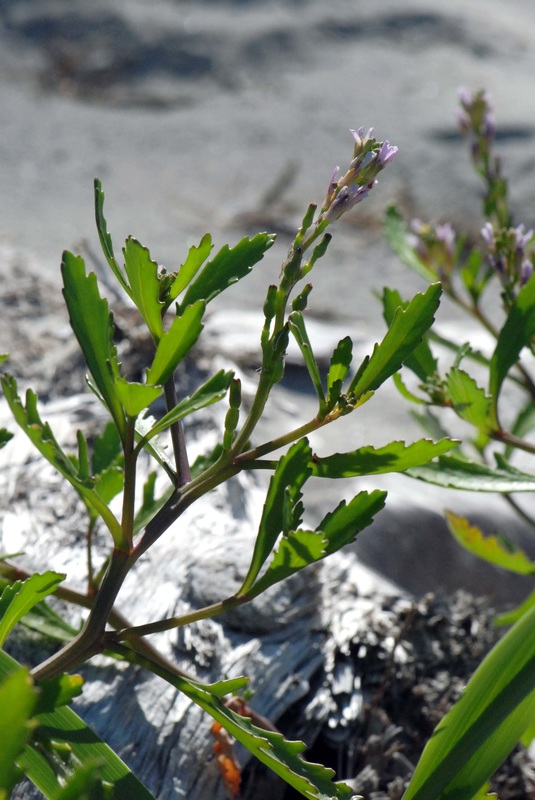American searocket • Cakile edentula
Identification
American searocket is a taprooted annual reaching 10-50 cm tall. It has branched, somewhat upright to sprawling stems and thick, fleshy leaves. The leaves have an oblong shape with serrated edges or shallow lobes. The flowers are four-petaled and range from purplish to white. Multiple flowers form clusters at the ends of branches or among leaves. The fruits are up to 2.5 cm long and appear in long clusters, which can make the stems bend over and sprawl across the ground.
Habitat & Range
American searocket grows on moist or wet sandy beaches. Its west coast range stretches from Alaska to California. It is also found on the east coast of North America; it tends to grow on ocean beaches on these coasts, but also grows on shorelines of the Great Lakes.
Similar Species
European searocket (Cakile maritima) is an introduced species found in some areas of coastal BC. It has larger flowers and the lower leaves (if not all leaves) are divided pinnately rather than lobed. The fruits of the two species differ as well: the bases of European searocket fruit expand out into 'wings.' See this west coast Cakile ID guide for further information on differentiating these species.
Intriguing Info
Some studies suggest that American searocket is native to Atlantic coastlines and was introduced to the Pacific coast. This is because of its unusual distribution in the Great Lakes and Atlantic coastlines as well as the west coast of North America.
The seeds of both searocket species float, making dispersal via water simple and effective propagation mechanism. European searocket appears to be replacing American searocket along the west coasts of both North America and Australia. See this species factsheet for more information. The distribution of both searockets, and the apparent displacement of one by the other, is the subject of the West Coast Cakile Project.
American searocket is a taprooted annual reaching 10-50 cm tall. It has branched, somewhat upright to sprawling stems and thick, fleshy leaves. The leaves have an oblong shape with serrated edges or shallow lobes. The flowers are four-petaled and range from purplish to white. Multiple flowers form clusters at the ends of branches or among leaves. The fruits are up to 2.5 cm long and appear in long clusters, which can make the stems bend over and sprawl across the ground.
Habitat & Range
American searocket grows on moist or wet sandy beaches. Its west coast range stretches from Alaska to California. It is also found on the east coast of North America; it tends to grow on ocean beaches on these coasts, but also grows on shorelines of the Great Lakes.
Similar Species
European searocket (Cakile maritima) is an introduced species found in some areas of coastal BC. It has larger flowers and the lower leaves (if not all leaves) are divided pinnately rather than lobed. The fruits of the two species differ as well: the bases of European searocket fruit expand out into 'wings.' See this west coast Cakile ID guide for further information on differentiating these species.
Intriguing Info
Some studies suggest that American searocket is native to Atlantic coastlines and was introduced to the Pacific coast. This is because of its unusual distribution in the Great Lakes and Atlantic coastlines as well as the west coast of North America.
The seeds of both searocket species float, making dispersal via water simple and effective propagation mechanism. European searocket appears to be replacing American searocket along the west coasts of both North America and Australia. See this species factsheet for more information. The distribution of both searockets, and the apparent displacement of one by the other, is the subject of the West Coast Cakile Project.
References
Cakile edentula (Bigelow) Hook. In Klinkenberg, Brian. (Ed.). E-Flora BC: Electronic Atlas of the Plants of British Columbia. Lab for Advanced Spatial Analysis, Department of Geography, University of British Columbia, Vancouver. Accessed 09/09/2013.
Pojar, J. and MacKinnon, A. (1994). Plants of Coastal British Columbia. Vancouver, BC: Lone Pine Publishing. P. 153.
Authors and editors of page
Kelly Fretwell and Brian Starzomski (2013).
Cakile edentula (Bigelow) Hook. In Klinkenberg, Brian. (Ed.). E-Flora BC: Electronic Atlas of the Plants of British Columbia. Lab for Advanced Spatial Analysis, Department of Geography, University of British Columbia, Vancouver. Accessed 09/09/2013.
Pojar, J. and MacKinnon, A. (1994). Plants of Coastal British Columbia. Vancouver, BC: Lone Pine Publishing. P. 153.
Authors and editors of page
Kelly Fretwell and Brian Starzomski (2013).







